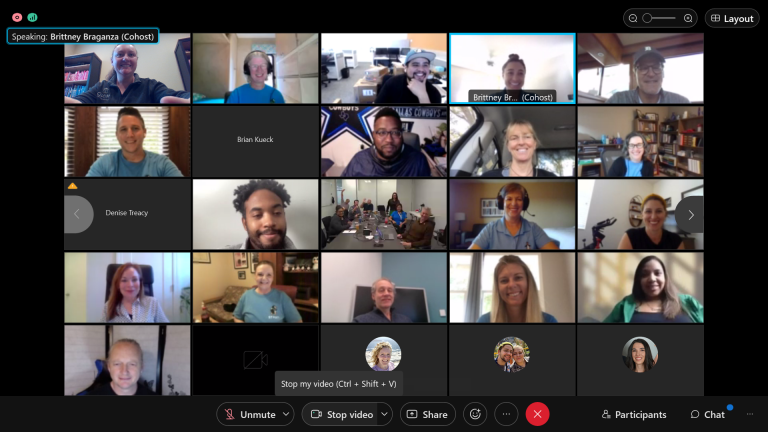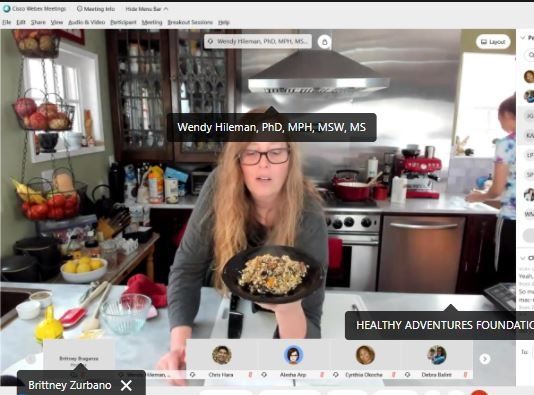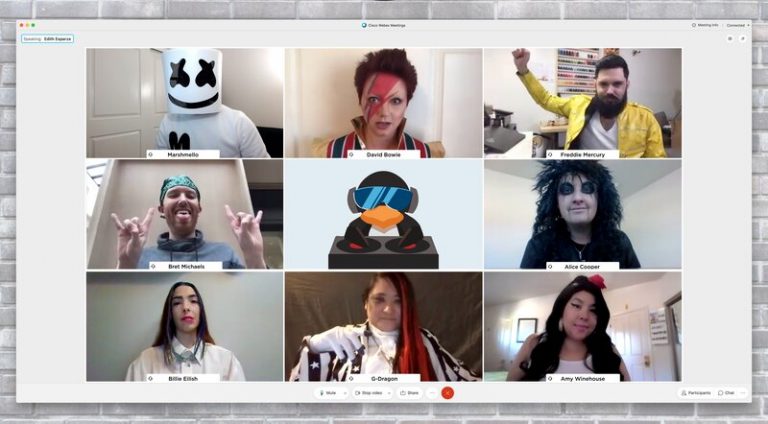As schools and offices re-open, you may be hearing more about hybrid learning and hybrid work. Students and employees are entering a new era with more flexibility to do some of their lessons or work remotely, while sometimes physically going to school or the office.
Navigating the world of hybrid work is no different for nonprofits adjusting to a new way of doing business. We recently connected with one of our nonprofit grantees, MIND Research Institute, to learn more about how they are using Cisco technology to embrace hybrid work.
MIND Research developed ST Math, a U.S. based, award-winning visual instructional program. With visual learning, there are no language barriers, so the program is accessible to all students, regardless of skill level or language background.
The people behind MIND Research are not only passionate about helping students learn math but also creating a work environment where everyone feels included. Cisco has made multiple product grants to them over the years, including Cisco collaboration tools like Webex, Webex DX80s, and Webex Room Series, which are increasingly important as they move forward into the hybrid landscape.
Collaboration tools = a more seamless transition
MIND Research, based out of Irvine, California, has 180 full-time employees and a little over 200 employees when you include part-timers. Employees are located across the U.S., from California to Texas, and Ohio and Massachusetts. MIND Research has been using collaboration tools successfully for many years and all employees have Webex accounts.
“As CEO, I expected to work nearly 24/7 through a crisis like the start of the COVID-19 pandemic, but my effort was matched and surpassed across the organization in ways I could not have imagined, and would never have asked,” said Brett Woudenberg, CEO of MIND Research. “Watching that happen while the entire team went remote from home was amazing. Our friends from Cisco have supported MIND Research with tremendous video conferencing hardware and software for years. They made our initial transition seamless, and they continue to sustain our hybrid work environment.”
Nearly all MIND Research colleagues are still working hybrid right now, with approximately 120 colleagues working remotely regularly. Brittney Braganza, HR Manager at MIND Research, shared, “More than half of our staff was remote previous to COVID-19. We were already using Webex for a lot of our meetings, so it was really easy for us to pick up and continue with business as usual.” MIND Research uses Webex as an internal tool to conduct trainings, company updates, virtual interviews, breakout sessions for wellness, and DEI brown bags. They also use Webex as an external tool to meet with people outside of the organization, like schools they serve or vendors.

Although they couldn’t meet face-to-face during the pandemic, Brittney noted that they were able to still connect personally through Webex, “Everyone did become a little bit more mindful about checking in with one another. Even though most people were remote, they liked being able to see each other’s face on video — that can make such a difference.”
Even the most extroverted employees found the transition more manageable with the help of collaboration tools. Kelsey Skaggs, Communications Manager at MIND Research shared, “I became a remote employee after working in our Irvine office for two years. Being a social person, I was really nervous about working from home. However, the transition felt quite seamless — largely due to Cisco’s in-kind gift of a DX80. This tool makes it so easy to stay in touch with colleagues. I love how it enhances remote communication by letting us see facial expressions, hand gestures and other movement. It really does make all the difference! The DX80 has been a perfect solution to all of the fears I had about being a happy and productive remote employee.”
Webex also made things easier for MIND Research when it came to recruiting. Usually, candidates need to do an in-person presentation, or the team would like to meet someone before bringing them on. “It’s really helpful to have Webex and for the candidate to be able to share their screen. They can control their presentation from their end, and there’s a chat so that they can put in questions along the way,” Brittney shared. Calli Wright, Marketing Manager at MIND Research, added, “I like the accessibility options as well, like chat along with the video. I’m hard of hearing, so that has been very helpful for me.”
Expanding collaboration capabilities
One great way MIND Research employees have stayed connected is through their monthly, all organization meetings called “MIND Update,” which they conduct through Webex. Calli shared, “It is a nice opportunity for the whole organization to see each other, to be connected, and to have that opportunity every single month to hear the big news from all the departments.” Brittney noted that it is helpful to record those meetings, so no one misses out on essential updates. She also shared how they bring a fun flair to the meeting as well, “We all try to wear some of our MIND swag, too. So, we’re all kind of matching. You’re seeing different iterations of MIND gear that people have collected over the years.”

MIND Research also uses Webex to facilitate wellness workshops with external experts once a month. These sessions have covered topics like financial, physical, and mental wellness. “We’ve done cooking classes, we’ve done yoga. It’s just really easy because everyone can join and listen in. It’s hard sometimes to make the time, so just creating an opportunity once a month to take a break, everyone’s super thankful for it,” Brittney shared.
When it comes to the DEI brown bags, they are monthly meetings conducted through Webex related to specific diversity, equity, and inclusion topics, and people join in on those to have conversations. Depending on how large that group is, they will break out into sessions with smaller groups to have more personal conversations.
MIND Research sees the potential that virtual events have on being more inclusive. They did their first all-virtual MINDshare (their all-org retreat) this year and plan to do it again next year. Rachel McKinney, a Customer Success Manager at MIND Research, recently wrote a blog post about her experience at MINDshare and noted, “In my short six months with MIND Research Institute, I picked up on one thing quickly: this organization does ‘virtual’ really well. MIND has a highly collaborative culture, and each person I’ve worked with, whether in California or on the East Coast, is always present and engaged. MINDShare was no different.”
What a hybrid model will look like for MIND Research Institute
When it comes to the hybrid work model at MIND Research, they have started planning that transition already. Some teams may rotate in and out of the office on a weekly basis to meet in person, so for example, the marketing team may go in on a Tuesday, and the engineering team may go in on a Wednesday. Brittney doesn’t see the office going back to full capacity anytime soon just because everyone’s been able to adjust well to being at home full-time.
Brittney reflected, “I think using technology will not be something that’s going to go away; it’s going to continue to be something that we rely on, especially since we have more people outside of California now that are based outside of the office. We’ll have teams fly into the office more often if they want to do in-person collaboration since it is always nice to see your team. But for the most part, I think it’s going to stay pretty close to what we’re doing now.”
Even when the hybrid model includes in-person meetings, not everyone will be able to be physically present. Eric Sbar, a Regional VP of Partnerships at MIND Research, shared, “I shipped a DX-80 to one of our team members before our last 3-day team meeting because she was past the point in her pregnancy when she could fly. It made a big difference for us and her – she could see and hear the room, and we weren’t straining to hear struggling computer or phone speakers to try to project her voice.”
Having everyone in the room, no matter where they are located, leads to a more inclusive work culture. It just takes reliable collaboration technology, and seeing the value in giving employees flexible work options, to make that happen.

Please visit our partner page to learn more about the impactful work that MIND Research Institute is doing to increase math proficiency.
If you are interested in learning more about hybrid work solutions, please visit Cisco’s Hybrid Work Index.



CONNECT WITH US